When Black is White

On sunny days, dark means hot. From our first bare-footed sprint across blacktop, we learn to associate dark colors with hot temperatures. It’s a generalization that influences color choices in everything from clothes to house paint to cars.
There’s more to the dark–hot association, however, than meets the eye. In truth, powerful mechanisms exist that allow objects to absorb, reflect and emit radiation outside the visible range. Consequently, surfaces that have the same visual darkness can reach very different temperatures when exposed to solar radiation.
Nature provides some of the best examples of keeping dark things cool. The darkest green tree remains cool to the touch. So does grass, even in the most intense sunlight. One reason for this is chlorophyll: a great natural infrared-reflecting material.
Although countless studies have been devoted to identifying the absorption/reflection mechanics of materials in ultraviolet (UV), visible and infrared (IR) portions of the spectrum, no novel inorganic pigments have been developed that optimize the optical properties outside the visible range — until now.
Research has led to a new generation of infrared reflective (IRR) pigments, the eclipseº products from dmc2 Degussa Metals Catalysts Cerdec AG. These revolutionary products apply the same phenomenon at work in chlorophyll to the world of inorganic pigments.
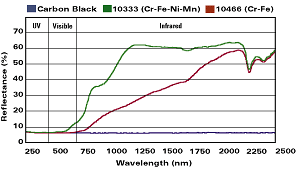 Credit: Degussa Metals Catalysts Cerdec
Credit: Degussa Metals Catalysts Cerdec
Basic Black - Infrared Reflectance and Accumulated Heat
To appear black, a pigment must absorb practically the entire spectrum of visible light. During the absorption process, light energy is converted to heat energy, causing the temperature of the surface to rise. Two of the most extreme examples of this are carbon black and copper chromite. These materials not only absorb virtually all the visible light that enters their surfaces, their absorption mechanism is so broad, it continues out into the infrared region as well.Specialized IR-reflecting pigments can be formulated to exhibit a more selective absorption band. While still absorbing most or all of the optical wavelengths, IR-reflecting pigments absorb less light near the cutoff between visible and infrared wavelengths. Much of this IR radiation is reflected instead of absorbed. The difference between a broadband absorbing black, such as carbon black and copper chromite, and IR-reflecting pigments, such as C.I. Pigment Black 30, Black 10333, and C.I. Pigment Green 17 and Black 10466, is shown in Figure 1.
 Credit: Degussa Metals Catalysts Cerdec
Credit: Degussa Metals Catalysts Cerdec Credit: Degussa Metals Catalysts Cerdec
Credit: Degussa Metals Catalysts Cerdec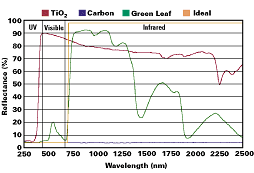 Credit: Degussa Metals Catalysts Cerdec
Credit: Degussa Metals Catalysts CerdecWhat’s an Idealized Pigment for Paint?
Coatings containing pigments that are able to absorb or scatter in the UV range are protected from polymer degradation due to free radical formation and chain scission. If the pigment is a UV absorber, the absorption mechanism will raise the temperature of the pigment, but this effect is minor compared to the heat build-up effects caused by absorption in the infrared range. Infrared radiation, however, does not pose a threat to polymers with regard to free radical formation and chain scission since the longer wavelengths, 700–2000 nm, pass through polymers with little to no absorption. The infrared absorption or reflectance of a coating is more often controlled by the pigmentation.In addition to strong absorption in the visible color space (400–700 nm), most black pigments used in coatings applications, such as carbon and copper chrome blacks, also absorb in the infrared range. Here, heat build-up becomes an obvious issue.
By absorbing only selective wavelengths, IR reflecting pigments stay cooler in sunlight (see Figure 3). The ideal IR-reflecting black pigment would absorb all UV light for weatherability plus all visible light to provide a dark color. As soon as the IR limit of the visible spectrum is reached at 700 nm, the pigment would change from absorbing to reflecting.
Comparing Figure 1 with Figure 3illustrates the degree of improvement necessary for the real pigment to become the ideal pigment. The difference is even more apparent when compared with chlorophyll — such as the IR reflectance spectrum of a tree leaf, which is also shown in Figure 3. The reflectance skyrockets in the near IR range, showing why nature still has the best IR-reflective pigment.
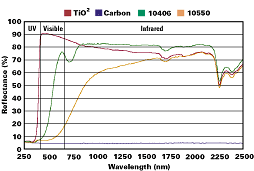 Credit: Degussa Metals Catalysts Cerdec
Credit: Degussa Metals Catalysts CerdecInfrared Reflecting Complex Inorganic Color Pigments
Traditionally, when selecting pigments for paint applications, properties such as color space, saturation, hiding power, UV opacity, temperature stability chemical resistance and weatherability come to mind. A pigment’s capacity to reflect heat, however, can be just as important and should not be overlooked.Roof and exterior building coatings top the list of typical applications where heat reflectance is important. Air conditioning, energy savings and comfort are important to consumers, and the use of IRR pigments can translate into real competitive advantages. Automotive topcoats formulated with IRR blacks reduce heat build-up and preserve the integrity of the coating surface. Gloss retention is predicted to be greater with IRR pigments and the period of retention may last longer.
Many unique applications for IRR black pigments are being developed as well. High durability coatings for offshore oil rigs and oil platforms, for example, present special challenges. Light colors can be blinding, and traditionally formulated dark colors show intense heat build-up.
Additional applications include military equipment, vessels and vehicles that require camouflage colors combined with low solar absorptance. This delivers energy efficiency and an overall cooler working and living environment.
Formulators may choose from organic and inorganic or complex inorganic color pigments (CICPs). Organic pigments offer the advantage of color space coverage and tinting strength. CICPs generally exhibit superior weathering properties, chemical durability and opacity. Paint industry applications that demand high performance and/or cost effectiveness generally use CICPs. For example, marine and naval applications typically prefer CICPs for their excellent weathering properties.
In both paint and plastics applications, CICPs are widely regarded for their high durability properties — weathering, temperature and chemical resistance, and UV scattering. The use of IRR pigments is not new. Both C.I. Pigment Black 30 and C.I. Pigment Green 17, which exhibit IR reflective properties, have been a popular choice since the 1970s. Their acceptance in the marketplace can be traced to the boom of the weatherable rigid PVC industry (e.g., vinyl siding, window profiles) that began more than 30 years ago.
White, the ideal IRR pigment, still reigns supreme in the vinyl industry. Over the years, however, other color choices have increased dramatically. As preferences shifted from pure white to beiges and grays, use of pigments other than TiO2 became necessary. Typical pigmentation for beige vinyl relies on CICP pigments for the brown (such as MnSbTi and FeTi’s) and yellow (such as NiSbTi and CrSbTi’s) components. These pigments deliver good-to-excellent infrared reflectance properties. For color matching, a black component is often necessary and more cost effective. When developing a gray or darker color, carbon black remains the traditional pigment of choice, even though its use results in higher heat absorption. Carbon black is relatively stable and inexpensive on a tint-strength-per-unit cost. CICP C.I. Pigment Black 28, a copper chromite composition, is another traditional choice, due to the pigment’s ease of dispersion, and even better stability with respect to temperature and environment.
However, in vinyl, as white began to lose market share to darker vinyl siding colors, problems arose. The glass transition temperature of most weatherable rigid vinyl compounds runs between 160°F and 180°F. Solar radiation heats the dark surfaces of the vinyl, causing thermal distortion and expansion problems.
To maintain a darker color and eliminate these detrimental effects, color formulators moved away from traditional black pigments and paid more attention to products with IR reflective properties. C.I. Pigment Black 30, a spinel formulated primarily with nickel, manganese, chrome and iron, and C.I. Pigment Green 17, with primarily chrome and iron, became popular. Black 30 pigments were more expensive, but provided excellent weatherability when a blue shade black was desired. Green 17 pigments, which tend to run more brown than green, were used mostly in beiges. The Green 17 pigments also offered the advantages of being less expensive with better IR reflecting properties.
Today, weatherable rigid vinyl applications account for over one half million pounds of infrared reflecting black pigments every year. Despite this phenomenal success, IR black pigments are not without their limitations. First, no existing IRR black chemistry can match the jetness of either carbon black or CuCr-type blacks. Additionally, as colors in this industry continually become darker, the existing technology does not offer sufficient IR reflection to maintain part temperature below the glass transition (Tg) point.
The vinyl industry, having recognized the original need for IRR pigments, now acknowledges the need for improvements. The coatings industry, too, has become more sensitive to the issue, as window lineal producers move to painted surfaces in order to achieve the darker colors consumers demand.
Infrared reflectance, heat build-up and energy efficiency are in the spotlight with the advent of higher energy costs. Studies and proposals are being made by the EPA’s Energy Star Program, Green Seal and Oak Ridge Laboratories to push for improved materials with low solar absorbance.
Enhanced color space coverage and reflectance properties of highly durable pigments are now a necessity — not only for the vinyl industry, but for numerous paint and plastic applications as well. The old adage of “lighter is better” just doesn’t cut it anymore. While white roofs may be an acceptable energy-efficient alternative for commercial buildings, homeowners demand more choice. As painted metal roofs become more popular on residential structures, consumers expect a wider range of colors from which to choose. Interior and exterior automotive applications, and marine and naval applications are two other areas where whites are not acceptable.
Most organic pigments, with the exception of carbon black, either exhibit good infrared reflective properties or are transparent in the IR region. In the CICP product area, titanium-based pigments all offer good IRR properties with high durability, but provide limited color space coverage, particularly in the brown region. Cobalt-based blues and greens have high IRR properties between 700 and 1000 nm, but they fall prey to a strong absorption trough above these wavelengths. The black color space is covered by essentially two chemistries — Pigment Black 30s and Green-Black 17. Both chemistries are limited by either color space coverage or IR reflective properties. While Pigment Black 30s produce blue undertones, their IRR performance is not exceptional. Conversely, Pigment Green-Black 17 delivers a good IRR performance, but its brown undertone eliminates it from applications where a more jet black is needed.
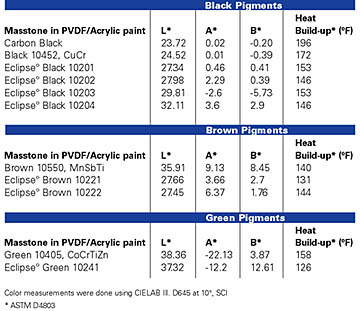 Credit: Degussa Metals Catalysts Cerdec
Credit: Degussa Metals Catalysts CerdecBreaking New Ground with Eclipseº
In the past, high durability was the major goal of a pigment. Now the need for durability is combined with the requirement for heat reflecting properties. Formulators want to deliver quality-of-life improvements without sacrificing energy efficiency. What were once regarded as luxury applications are now commonplace, and the potential for new applications is only beginning to be explored.The market factors driving this new way of thinking are programs and initiatives mentioned earlier, including the EPA’s Energy Star Program, Green Seal and Oak Ridge Laboratories. These programs have focused an increasing amount of attention on the merits of energy-efficient structures and vessels.
dmc2 Degussa Metal Catalysts Cerdec Corp. wanted to develop a black pigment that would demonstrate high infrared reflection characteristics, and show a more neutral-to-blue undertone. Chemists were also interested in eliminating chromium from the pigment formulation. Although their research efforts were focused on the infrared reflection properties of CICPs, they were not limited to existing chemistries.
The result was two pure blacks: eclipseº Black 10201 and eclipseº Black 10203. Both are novel pigments with patents pending. The summarized color data in Table 2 and spectral reflectance data in Figure 4 show that both pigments have excellent infrared reflectance relative to existing chemistries. Both allow formulators to access the bluer undertone color space.
 Credit: Degussa Metals Catalysts Cerdec
Credit: Degussa Metals Catalysts CerdecAlthough research targeted the black color space, a number of other pigments, based on novel and conventional chemistries, were also produced. In each case, the products offer either an improvement in infrared reflection properties and/or unique color space advantages over existing pigments.
All eclipseº pigments are produced by high temperature calcination and have all or most of the attributes typically associated with complex inorganic color pigments.
 Credit: Degussa Metals Catalysts Cerdec
Credit: Degussa Metals Catalysts CerdecEvaluating IR Pigment Performance
It is necessary to go beyond the basic mechanics of IR reflecting pigments to quantify the performance of these new IRR products.To determine how much solar radiation each pigment reflects, multiply the percent absorbed by the solar intensity at each wavelength. The final absorption for all wavelengths is calculated and divided by the total energy of the sun. This value is referred to as alpha subscript sun. As previously stated, broadband absorbing pigments typically have values of alpha approaching 1.0 and reflectances of all wavelengths approaching 0. A plot showing total solar energy and percent reflected for a broadband absorber, two traditional IR reflecting pigments, and two Eclipseº pigments is shown in Figure 5. Calculating the total energy reflected, or 1µ, gives a better measure of the theoretical amount of energy that will be reflected for a range of infrared reflecting pigments. This total amount reflected is shown in Table 3. The new pigments have excellent reflective properties compared to the conventional IR reflecting pigments.
This improved performance may also be demonstrated by standard test methods. The measurement of heat build up in vinyl, ASTM D 4803, describes a pigmented material subjected to a visible-infrared lamp. In this test technique, the sample is left under this illuminant with an insulating backing until the maximum temperature is reached. This test was performed on fulltone pigments in the Kynar® system. The results, shown in Table 2, clearly demonstrate the improvement possible with these new IR reflective pigments.
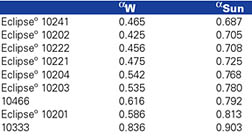 Credit: Degussa Metals Catalysts Cerdec
Credit: Degussa Metals Catalysts CerdecDark Colors Can Be Very Cool
IRR pigments end the conflict between cosmetic preferences and efficiency. Whether designing a roof to reduce air conditioning output or keeping a part cool to eliminate thermal distortion, the new generation of IRR products prove that pigments can be more than colorants – they can also impart critical functionality.Accordingly, color formulators, who regard hiding power and UV opacity as key functional attributes of CICPs, now have new options that provide better IR properties and an expanded color space. This combination offers several new application possibilities for formulators, who are sure to discover that dark colors can, in fact, be very cool. c
For more information on IR-reflective pigments, contact Gil Burkhart, dmc2 Degussa Metals Catalysts Cerdec, Performance Pigments and Colours Division, PO Box 519, Washington, PA 15301; phone 724/223.5949; fax 724/229.5388; e-mail gil_burkhart@dmc-2.com.
Looking for a reprint of this article?
From high-res PDFs to custom plaques, order your copy today!





